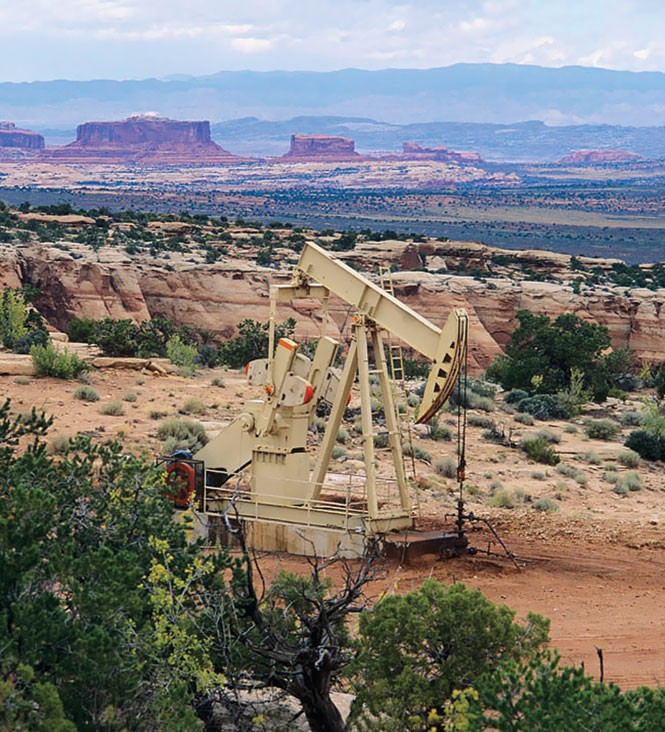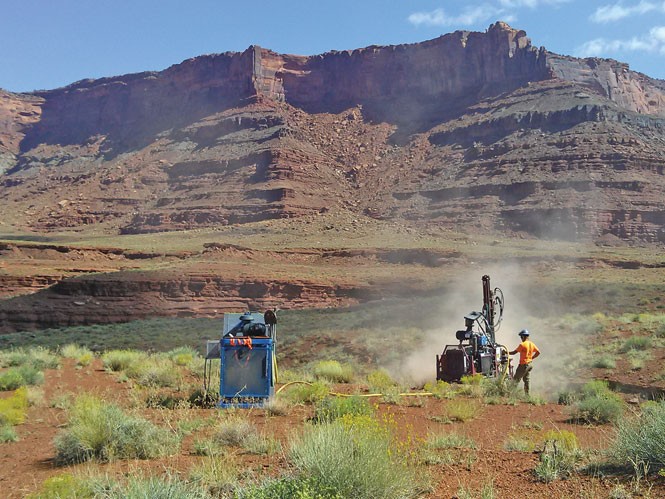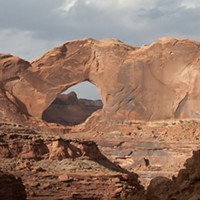Page 2 of 2

First Steps
Big Flat isn't the only area within the monument proposal that is slated for oil, gas and mineral development: 210,000 acres within the proposal are already leased, and up to another 1 million could be available pending the finalization of the MLP. All told, 63 percent of the lands within the proposed monument area are open to potential development.
In September, Fidelity began 3-D geophysical seismic work on Hatch Point, about 15 miles south of Moab. The area being surveyed is approximately 50 square miles, and is contained entirely within the Canyon Rims Recreation Area. Three scenic viewpoints, as well as Hatch Point Campground and the Trough Springs trailhead, lie within the project area.
Seismic work is performed by laying out a grid pattern of "source lines" across the landscape. A shock wave is created at various source points along those lines, either with a buried explosive device or with vibroseis trucks, sometimes called thumper trucks.
Thumper trucks drive cross-country, over vegetation and natural features, and thump the ground at source points with a large, hydraulic weight. The shock wave reflects off of geophysical structures underground, and is picked up by a device called a geophone. The resultant data is used to map the underlying structure to help geologists determine where oil can be found.
"It's disingenuous to say these lands enjoy any current protection when a thumper truck is coming right by your campsite in a designated recreation area," Gross says. "It just goes to show how the current management regime is failing, and why these are the places that need protection as a Greater Canyonlands National Monument."
About 4,000 acres of the project area spill over the rim into Lockhart Basin, the first modern incursion into the greater Canyonlands Basin. Source points in Lockhart are being placed with portable drills that are dropped in by helicopter. Though Rasmussen states emphatically that Fidelity has no plans to develop Lockhart, many fear that this is the first step toward industrialization "below the rim."
The Proposal
The concept of protecting a large chuck of southeastern Utah goes back as far as 1936 when Harold Ickes, secretary of the interior under President Franklin Roosevelt, proposed the 4.6 million acre Escalante National Monument.
The proposal encompassed lands surrounding the Colorado River and its tributary canyons along most of its course through Utah. It would have included most of what is currently proposed for Greater Canyonlands, the Colorado River country around Glen Canyon (now inundated by Lake Powell), Capitol Reef National Park, and what is now the Grand Staircase-Escalante National Monument, which was designated by President Clinton in 1996.
Opposition from the Utah congressional delegation, as well as the diversion of national attention to World War II, derailed the proposal, but in the 1950s, Bates Wilson, a young superintendent of Arches and Natural Bridges national monuments, began a quest to protect the area that would eventually become Canyonlands National Park.
Wilson found allies in then Secretary of the Interior Stewart Udall, and Utah Sen. Frank Moss. The three worked tirelessly on the political front, as well as on the ground, taking politicians on jeep and river tours into the remote and rugged canyonlands backcountry.
They succeeded in bringing the proposal before Congress, but the final designation of the park included only 277,000 acres, a fraction of the 990,000 acres proposed. An additional 60,000 acres was added in 1972 with the inclusion of the remote Maze District in the southwest portion of the park.
Dabney is advocating enlarging the park to its original "rim to rim" proposed boundaries and slightly beyond to include Beef Basin, upper Salt Creek, and Fable Valley, known for their shared archaeological heritage with the Canyonlands Basin.
Gross says that the rim-to-rim proposal doesn't go far enough—there are many more lands surrounding the Canyonlands Basin that are worthy of protection, he says.
"You can't just go rim to rim and protect the watershed," he says. "You need to protect the view shed. Otherwise you'll be standing at the Needles Visitors Center and be looking up at oil & gas wells. The sunset at Grand View Point will be echoed by flaring gas wells on Hatch Point."
The Greater Canyonlands Coalition is proposing the preservation of 1.8 million acres of public land surrounding Canyonlands National Park. Protection would be provided for outstanding scenic areas such as Labyrinth Canyon on the Green River; Lockhart Basin and Indian Creek within the Canyonlands Basin; the canyons of the Dirty Devil River and Robbers Roost country; as well as the archaeologically and culturally rich areas of upper Salt Creek, Beef Basin and the tributaries of White Canyon.
"The boundary was drawn with the manageability of the lands in mind," Hedden says. "We are trying to protect the world-famous wildness, silence, unspoiled vistas, dark night skies, critical watersheds, wildlife habitats, cultural resources and recreational opportunities."
Politics ... As Usual
In August, 14 senators, led by Dick Durbin of Illinois, sent a letter to President Obama urging him to designate a Greater Canyonlands National Monument.
"Greater Canyonlands is one of our nation's most stunning, wild, and scenic landscapes," the letter said. "It should be protected permanently for the benefit and education of future generations."
Commissioner Lyman says Durbin and the others "may be well-intended, but ... they are misinformed," and that Utah does not need another layer of federal intervention.
"Utah is beautiful not because of regulation, but because God made it that way," he says.
In response to the threat of a national monument, Utah Rep. Rob Bishop has been championing his "Grand Bargain," or "Utah Public Lands Initiative." He describes the process as "bottom up," whereby interested stakeholders and local communities work with their county representatives to draft a vision for federal land use within their jurisdictions. Bishop plans to package the local recommendations into a bill that he can present to Congress sometime next year.
At a Grand County Council meeting in July, Kathleen Clarke, director of the Utah Public Lands Policy Coordination Office, spoke of the "looming danger" of a national monument and urged council members to work with interested stakeholders, adding that, "We absolutely need the support of the environmental community."
The council had previously drafted three alternative land-use maps for the management of federal public lands within Grand County. Alternative 1 provided the least amount of protection for public lands, while Alternative 3 represented the council's version of a plan that would offer the most protection through wilderness designation.
The alternatives were widely seen by the recreation and environmental community as being almost entirely pro-development, offering very little as a range of possibilities for protective designations.
"Grand County's best alternative protects just over 50 percent of the proposed wilderness in Grand County, and leaves open to oil & gas drilling the entire view shed east of Arches National Park," Gross says. "At best, we could call Alternative 3 a starting point for discussion, but it's not much more than that."
The council has continued to revise its proposal by expanding wilderness designation and by forming a subcommittee to work on the designation of national recreation areas, but has yet to vote on a proposal and send it to Bishop.
In neighboring San Juan County, a group of stakeholders—ranchers; oil, gas & mining proponents; ATV enthusiasts; and one conservationist—has been meeting every two weeks for the past six months to draft a proposal for the county commission.
Their alternatives were released in October, and include a wide range of possibilities. Alternative 1, or the "unanimous alternative," designates as wilderness all of the 500,000 plus acres in San Juan County that is currently being managed by the BLM as Wilderness Study Areas. It also sets aside large tracts of land in Indian Creek, valued for its scenic and recreational values as a National Conservation Area.
Josh Ewing, executive director of the Friends of Cedar Mesa, says, "The respectful, collaborative and open-minded spirit of these discussions are a credit to what our community can accomplish if we work together and find common ground."
In August, Utah Republican Rep. Jason Chaffetz brought Democratic Rep. Elijah Cummings from Baltimore, Md., to Southern Utah to show him how people out here "really feel" about a monument and about federal control over public lands in general.
They attended a round-table discussion with rural county commissioners, many in boots and cowboy hats, with each speaker repeating how much they resented the intrusion of the federal government and how opposed they were to the creation of a national monument. No members of the public were present, nor any members of the environmental or recreation community.
After the meeting, they went to see Arches National Park. On the ride up, Chaffetz berated the Park Service, in the presence of park superintendent Kate Cannon, for its inability to manage the lands with which it's entrusted, and said it has no business taking on more. He cited the October 2013 government shutdown—which he'd supported—as the perfect example.
Chaffetz told Cummings that states were much better equipped to manage the public lands within their borders. The two then stopped for a photo-op at the Windows Section of the park. With the morning sun still rising, they couldn't pose with North Window Arch behind them, so they turned and faced east. In the distance, the developing Big Flat oil field could be seen over their shoulders.

- Seismic work “below the rim” in Lockhart Basin
For Antiquity
The Antiquities Act, which gives the president the power to designate a Greater Canyonlands National Monument, was passed by Congress, and signed into law by President Theodore Roosevelt on June 8, 1906. The act authorizes the president "in his discretion, to declare by public proclamation historic landmarks, historic and prehistoric structures, and other objects of historic or scientific interest ... to be national monuments."
The act has been used more than 100 times by presidents from both sides of the political aisle, including George W. Bush, Jimmy Carter and Dwight Eisenhower, and has established some of the nation's most beloved and visited national monuments, many of which eventually became parks, including Grand Canyon, Grand Teton and Arches.
Jackson says that while the Antiquities Act has indeed been used to protect revered national parks, "we need to rethink the Antiquities Act and bring it back in line with its original intent, protecting high-value areas of antiquities."
In their letter to Obama, the national senators made the case that Greater Canyonlands, as the ancestral home to several tribes of Native Americans, is the perfect candidate for protection under the Antiquities Act.
"It includes thousands of cultural and archaeological sites, a hunting site that dates back 12,000 years, and more recently built granaries nestled into the canyon walls," the letter said.
Will President Obama designate a Greater Canyonlands National Monument? At a Sept. 17 news conference, Utah Gov. Gary Herbert said that Secretary of the Interior Sally Jewell assured him that "a monument wasn't imminent," and that she would tell him if it were.
But Hedden says that protection of Greater Canyonlands by executive order is necessary now because of unprecedented threats to the region from new drilling technologies and modern off-road vehicles.
"It is time to finally redraw the boundary the way it should have been from the start," Hedden says, "so that this remarkable place can be managed for its highest uses as a repository of our cultural history, haven of biodiversity, and a refuge and inspiration for people from all over the world."
